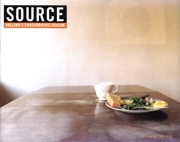Single Supper Only
by Aidan Matthews
Issue 17 Winter 1998
View Contents ▸
View photographs from: Dinner For One ▸
Institutional cutlery, half-eaten fast-food on functional plates, the haunted scantiness of countless galley kitchens where the single and the separated and the solitary preside as the absent hosts of their almost meal, their ghosted feast, their posthumous banquet: this is the landscape of the lone individual, the student's fish and chips, the spinster's yoghurt, the spoon-fed psychogeriatric's plastic beaker, the bachelor's rewarmed steak and kidney pie. It is the territory of the one who eats by themself, an involuntary anchorite, as only the outcast and the scapegoat ever did before; and who eats by themself in the recent aftermath of the historical ritual that humans once called a meal, imagining it immemorially as the principal event by which any community comes into being.
Who might live in these quiet pictures, inhabit their closeted Dutch stillness? Here a table's set for three but serving a single supper only, with two chubby apples in a fruitbowl; here again a soup-bowl full of beans cools and congeals by a bedroom radiator with Boxer shorts or a tank-top stiffening dryly on it near a long electrical flex that marks the map-line of a Iatitude running through all rented accommodation. In a third the bowl's abandoned between opened letters and the Biblical immensity of the new Book of Life, the telephone directory, while another shows us a plate of boil-in-the-bag rice on a bentwood chair in a room with a small disturbed bed and cracks in the wall where a head might rest, looking out at us looking in at it...
In both the photographic and the gastronomic sense, then, these resolute images - dignified, frugal sightings which transform the sociological phenomenon of casual eating into complex liturgical acts - provision in turn ten replete sittings. Yet this feast for the eyes begins in solo snacks - microwaved carbohydrates, fragile calorie-conscious salads - which have been broken off, laid down, or set aside by the discrete etcetera of their own private and impenetrable narratives and which accomplish completeness for us precisely by disclosing sacredness in the pathos of their nonconsummations.
You don't have to read Levi-Strauss to affirm the primacy of the shared kill in the human economy. It is our everyday experience of the world that the transformation of food into feast is the metaphoric centre of our self-understanding. The drama of the meal, which is about relationship and reciprocity, has less to do with metabolism than with mutuality, less to do with nutrients than with nourishment and less to do with nourishment than with nurturing. We sit together, we break bread, we derive our most authentic self from the sodality of others. The Mass itself, however we seek to sophisticate its enactment, remains always and everywhere a telling of stories and a sharing of food, for it is the history of an actual dinner and the repetition of it. Indeed it is the repetition of a repetition since the Last Supper was a Seder, which commemorated the Passover meal.
These bountiful images consider the short commons of late modernity in the city of bedsits, the breakfast TVs and the TV dinners and the pining multivitamin breakfasts which pass for the breaking of fast. A take-away pizza, the ancient dish par excellence of daily sharing, of family companionship, of Latin viaticum, features uneaten (inedible?) in one photograph; the milky haloes of slopped bottle-ends on a plain tabletop amount to a sum of zeros in another. Yet these beautiful photographs are not bleak. They are not ironic. They are certainly not cynical. Instead they companion the damaged quotidian planet, which is to say -cum pane- they break bread with it. They are in charity with the imperfect world. They hunger and thirst for it. They gaze upon bread and butter until the reverence of the gaze divulges bread and wine in the still life of their little collation. They consider the culture of consumption until it discloses in its deepest aspect a hidden form of holy communion.
So they feed and refresh us, these icons of the platter and the cup. They set a place for us at the table. They enact a Grace before Meals and a Grace after Meals. If that grace were embodied in words, they might be taken from the vulgate phrase in the Passion narrative of the Christian scriptures, from the last word of the Galilean who adored eating and drinking with allsorts as a sign of the Kingdom come, from his 'Consummatum est', an expression which means not only, 'It is completed' but also 'lt has been consumed'.
Other articles mentioning Martina Mullaney:
Other articles on photography from the 'Conceptual' category ▸






